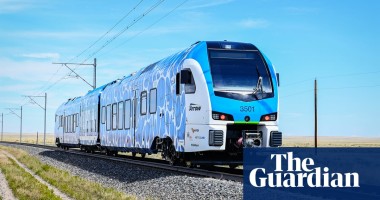‘Transformational’: how a California city launched America’s first hydrogen-powered passenger train angielski
There’s a new train pulling into the station in San Bernardino, a southern California city about 60 miles from Los Angeles. From the outside, it looks like any other commuter train, with three passenger carriages, blocky windows and a colourful blue exterior.
But inside, it’s unlike anything the region – or the country – has seen before. The $20m Zero-Emission Multiple Unit, known as Zemu, uses a hybrid hydrogen fuel cell and battery system to propel the train and run other onboard electrical systems. The only byproduct of the fuel cell is water vapour, a welcome change in an area known as the Inland Empire that suffers from some of the worst air quality rates in the country.
The new technology will make Zemu the first hydrogen-powered, zero-emissions passenger train in North America to meet Federal Railroad Administration (FRA) requirements when it goes into service early next year.
…


Dodaj komentarz